|
Camp-X ‘Hydra’
This site is dedicated to ‘William Hardcastle’
June 22, 1914
May 2, 2002
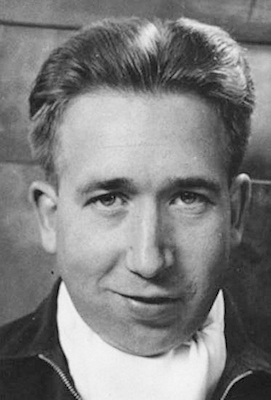
William Hardcastle
VE Day

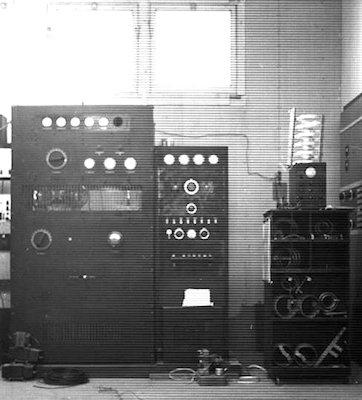
Part of Hydra’s main transmitter (note tuning coil on top of cabinet at right)
(Author’s note: The code name ‘Hydra’ was given to the wireless installation because it was like the “mythical beast of the same name, a ‘many headed’, triple diversity creature” which would communicate continuously during the war years with England’s Aspidistra.)
When Bill Hardcastle (Yorkie) had his first interview with Bill Simpson, he had no idea that he was going to be trained as a secret agent. He believed that he indeed was going to be doing something top secret having to do with Morse Code, but it was only at his second interview, this time with Tommy Drew-Brook, that he found out that the BSC had plans for him in South America.
Bill was intrigued by the possibility and was very much looking forward to his new assignment. After all, he had gone from his mundane job at The Toronto Star to becoming an agent-in-training all in just a few days.
At the time that Bill was being trained, the Camp was determined to be an excellent location for the transfer of code, much better than was Ottawa. The topography of the land and the lake made it an excellent site and signals would arrive distinctly and rapidly from the UK. Because there was a shortage of expert radio operators, Bill soon realized that any hope of his being posted as a secret agent overseas was dwindling rapidly. There was a much greater need for trained personnel to build and operate Hydra.
As mentioned previously, the building that would house Hydra was the most mysterious looking building at the Camp. It was a four-sided structure, completely open on the inside, with windows all around but placed seven feet above the ground for obvious reasons of secrecy. The building had only one entrance and that was at the front; two large doors making it easy to bring in large equipment.
One day, not long after Bill arrived, a large van drove into the Camp and delivered crates of communications components. When it all was unloaded, someone yelled, “Go to it, fellows!” Bill and his mates proceeded to build a complete, working communications installation from a photograph. They hooked it up, and Hydra was born!
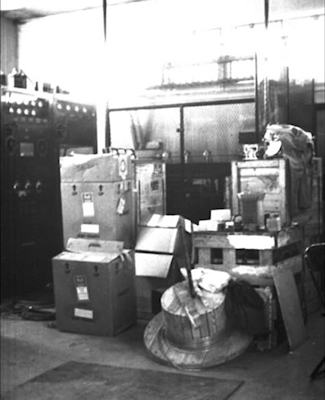
Hydra arrived as components from various sources
Here it sits in its containers, ready for assembly.
Bill has often been asked where they were able to find the parts for the Hydra operation. There was a lot of money available to them, so Bayly and his men simply went around buying entire sets from amateurs here and in the U.S. The Camp acquired a 1-KW (one thousand watts) rig from Toronto with monstrous tubes but very well designed. It, too, arrived at the Camp in pieces to be re-assembled on site.
Most of the big transmitter complex was “Jerry-built”. Parts came from everywhere. One transmitter had been a 10-KW (ten thousand watts) station in Philadelphia, WCAU. It was highly experimental and years ahead of its time. Governments appropriated and shut down such rigs for obvious reasons when war broke out, as they presented a potential threat to national security, and as well, provided installations such as the Camp’s, with state of the art equipment.
By the time Bill completed his course at Camp X, he was prepared to undertake a clandestine wireless operation in South America. He was trained to intercept, decode, re-code and then transmit messages back to North America. German submarines were a likely source of radio traffic in Buenos Aires, where Bill was told he was headed. Actually Bill, and his partner Jack, from Toronto, were to cover South America as far south as Lima, Peru. Most of that continent was fairly heavily involved. Clearly Hitler’s next blow was aimed there, or so it seemed in 1942. Bill was anxiously awaiting his posting since he had been told that Buenos Aires was a hot bed of German agents.
Bill and Jack were told that they were short of space at the Camp and that the two men were to stay in Toronto until contacted, so they waited for some word as to what was happening. Eventually they were advised that the plan had been aborted and that they would not be needed anymore. After Bill heard the news, he went off and joined the Air Force (RCAF) as he had tried to do earlier, but had not been called up because of his colour-blindness. However, because it was now wartime, the Air Force overlooked the colour-blindness as they were short of wireless operators.
The very day that Bill Hardcastle joined the Air Force, Bill Simpson contacted him and said that he was needed right away. Naturally, Bill (Hardcastle) had to tell him that he was “too late”. Simpson’s response was typically brief. “Don’t worry at all. I’ll take care of it”. So, while Bill was awaiting his instructions, he attended one course at the Air Force training centre. He received all A’s and the Air Force made him an instructor.
He was assigned to Montreal, Quebec, as an instructor-in-training. Each trainee had to start coding at one word per minute, but the instructor said that Bill, who was already capable of working much faster, would not have to sit in because it would be a waste of his time.
The day that Bill was informed that he was to be an instructor, he thanked them for the offer, but indicated that he expected he would be going back to Toronto. Sure enough, the very next day he was back at Camp X wearing an RCAF uniform. He was given permission to keep the uniform as he was entitled to wear it, which he did proudly. At the Camp, he was the only personnel in RCAF dress.
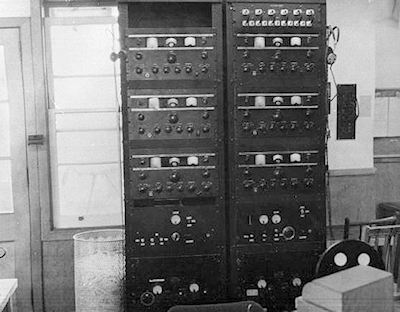
The radio room (Note the headsets at right)
This exact radio is on display, in working order, at the Robert Stuart Camp-X Museum.
Things were going very well, even after Bill had gone back to the Camp, until the Air force lost record of his address. Somehow they had muddled a few numbers and Bill’s pay cheques were going to 1145 King Street, in care of Hardcastle, Aircraftsman, and then ultimately to the dead letter office. They should in fact have been sent to 25 King Street, Room 1145 (BSC HQ in Toronto). Bill went to the Air Force paymaster and was informed that they had accumulated approximately three thousand dollars in back pay for him. Innocently Bill said, “I’m sorry, I can’t take it.” Bill tried to refuse the pay because he felt he was not entitled to it, but the paymaster was adamant. He said he did not care what had happened but he just wanted to clear up his bookkeeping. Bill got in touch with Drew-Brook who told him to, “Just leave it there.”
The Camp Commandant ordered Bill to go to British Columbia to complete a wireless course run by the Air Force. The course instructor did not realize that Bill had experience with high priority transmissions as he was unaware that Bill had previously trained at Camp X. For that matter, he was not likely even aware of the Camp’s existence. One morning, he looked over the forty five students in the class and told them that a coded message consists of the preamble “P”, for priority and then the type of priority, such as “OU”. The OU indicated “Top Priority”. Then he said, “None of you buggers will ever see anything like it, but I’ll mention it anyway.” Little did he know that Bill had been putting these transmissions through the Camp, almost routinely, every day.
An OU message goes straight to the heads of state and military chiefs of staff. Such messages obviously contained information requiring the highest level of security clearance. Bill found the instructor’s attitude amusing but never let it be known exactly what his own position was.
Once the equipment was operational, Bill Hardcastle and Bernie Sandbrook personally sent the very first messages from Hydra to England. Occasionally, the English sergeants would come into the radio room and plead with Bill and Bernie to be allowed a crack at sending some Morse. These sergeants had been wireless instructors in Hong Kong prior to its capture by the Japanese, and they were first rate in their work at the Camp. Once in a while Bill broke down and let them ‘send’ (transmit) as he did not see any harm in it. The sergeants were very good, and the codes were indecipherable anyway.
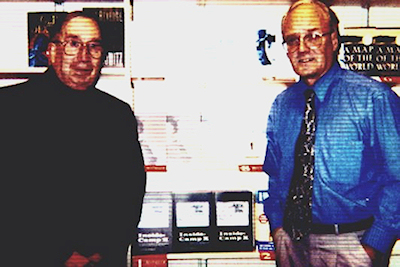
Bill Hardcastle and Lynn Philip Hodgson
Bill and his colleagues would receive German messages which had been intercepted by our agents in South America, re-coded, and then sent along to Camp X. Ironically, had Bill been sent to South America as originally planned by the BSC, he would have been sending these very same messages instead of receiving them.
Hydra had direct access to Ottawa, New York, and Washington using lines belonging to Bell Telephone, as well as to Canadian National and Canadian Pacific. The use of these lines was very costly, but the Bell representative told Bill that the Camp had a higher priority than even the Prime Minister’s Office. When the Camp wanted something repaired or serviced, Bell would be there immediately!
(Author’s Note: During my interviews with Bill Hardcastle, he was able to give me accurate and concise information as to how the Hydra operation was set up and how nothing would have worked without the massive rhombic antennae which were donated and erected by Ontario Hydro.)
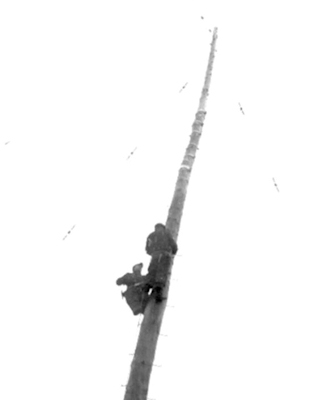
Ontario Hydro workers erect Rhombic Antennae for ‘Hydra’.
There were three sets of these rhombic (diamond-shaped) antennae, each set strung between four telephone poles stretching from Thornton Road to Corbett Creek. Mr. Edmonds, from Ontario Hydro, worked at the Camp and it was he who selected the poles and looked after the construction.
The beauty of the rhombic design is in its ability to cover the greatest number of frequencies in the least amount of space. In addition, these rhombics had very high gain (sensitivity), and a slow fade-out effect. The technology was fairly new, but very sophisticated. The antennae had air, dried in silica, pumped through them into the dipole (hollow ‘wire’) to maintain a dielectric charge.
The three sets of rhombics fed into one triple diversity receiver. These three fragments were blended into a single signal which was then stored as a series of raised dots on paper tapes. One of the most senior of the officers was a leading expert in short wave and rhombic theory. He would go out at night and ‘shoot’ the Pole (North) Star; there was no room for error. During winter ice storms, quite marvellous displays of The Northern Lights could be witnessed on the rhombics. One guard actually thought they were under attack by the enemy the first time he saw this phenomenon.
The busiest time in the radio room was during the day because radio signals can be “made to bounce or ‘skip’ off the electrically charged ionosphere perfectly during the day but, at night, they often produce fade-out.” It would require three “skips” for the signal to go from the Camp to England. The signal bounced down from the ionosphere to the ocean’s surface and back up and so on until it was received by another of the rhombics in England.
Information was stored on different types of paper tape, each a little different in size and in the spacing of the dots and dashes. In-coming messages were automatically stored as dots on tape and then re-transmitted later. In the evening, when things were quieter, they would run the tapes through a Bomack machine which cranked the data out at 190 words per minute. Most of the time, things went along fairly routinely and Hydra functioned simply as a clearing house for information from the embassies in Washington and other foreign centres.
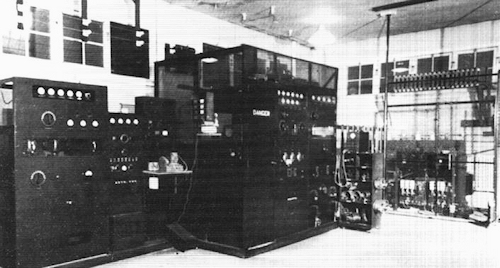
Inside Hydra (Note the high windows to avoid snooping eyes)
One day the installation was nearly put off the air permanently due to carelessness. Someone had been using the “XMTTR” (transmitter) and went to the mess at supper time. He sat down next to Bill Hardcastle. Bill asked, “Who’s at the radio?” The man answered casually that he had finished at four o’clock and did not know who, if anyone, had replaced him. That meant that the radio was “on” but that it was probably not being driven.
Bill ran across the road and opened the doors. The heavy smoke just about knocked him down and he could see a roaring red fire in the corner. The fire extinguisher was on the opposite wall from where he stood. Bill fought his way to it through the dense black smoke and deployed the extinguisher, but its capacity was not sufficient to put the fire out. Bill grabbed three buckets of sand that were kept nearby. He knew that the sand could potentially destroy the transmitter, but he figured that the “XMTTR” was ruined by now anyway so he threw bucket after bucket of the sand on it, finally smothering the flames. The fire had nearly consumed the new XMTTRs which Hughey Durant and Bill had just finished installing.
There was no off/on safety switch on the transmitter. If you had reason to go behind the XMTTR you took the risk of tangling with five thousand volts of electricity. Many times men came close to ‘getting it’ back there.
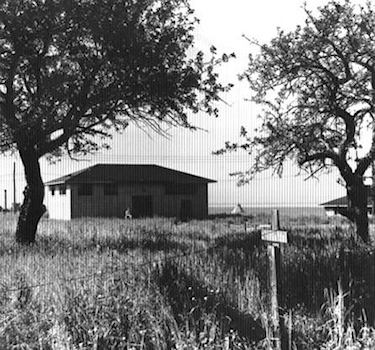
Bill Hardcastle sits outside ‘Hydra’, August 1942
Anticipating a particularly busy day, Bill Hardcastle, Hughey Durant and Bernie Sandbrook were once asked to work in the Communications Building on the Morse machines. Bill recalled that he was working the teletype machines. The raw data would come in through Hydra and flow through to the Communications Building where it would be printed out in five-letter code.
Bill and the others were receiving coded messages from England that particular day, turning them around and Morse Coding them to BSC in New York. Suddenly, a flurry of OU “Top Priority” messages starting flying out onto the printer, one after the other.
(Author’s note: An OU message was the highest level of priority that was established. If an OU message was received, everything else ceased automatically and the OU message was processed immediately.)
Bill was so alarmed by this seemingly endless stream of about fourteen OU messages that he did exactly what he was trained to do; he dropped everything else and started pounding out the keys to New York as quickly as he could. At the same time he turned to his fellow mates and said, “Hey boys, I think this is it! I think the invasion has started!”
An excellent guess; it was June 6, 1944!
‘D’ Day!
For more information on ‘Hydra’ and Camp-X, please read, ‘Inside - Camp X’
|

 (289) 828-5529
(289) 828-5529